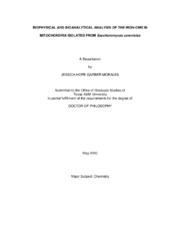| dc.description.abstract | An integrative biophysical and bioanalytical approach to studying the Fe
distribution in isolated mitochondria was developed. This procedure involved
large-scale growths, the inclusion of a chelator in isolation buffers and an
anaerobic isolation protocol. Electron microscopy confirmed that mitochondrial
membranes were intact and that samples were largely devoid of contaminants.
The Fe-ome-the sum of all Fe species in mitochondria--was studied using a
combination of EPR, Mossbauer Spectroscopy, Electron Absorption, ICP-MS
and Protein analysis.
Isolated mitochondria were packed prior to analysis to improve the S/N
ratio. The residual buffer content of sample pellets was determined by use of a
radio-labeled buffer. There was essentially no difference in the packing
efficiency of mitochondria isolated from respiring and fermenting cells. The
determined packing factor, 0.80, was used to calculate concentrations of
individual species in neat mitochondria.
The Fe-omes of mitochondria isolated from cells grown on respiring,
respirofermenting and fermenting media were determined. Neat mitochondria
contained ~ 750 mM Fe, regardless of whether the cells had been grown on
respiring or fermenting media. The Fe distribution of respirofermenting samples
(which can undergo respiration and fermentation simultaneously) was nearly
identical to that of respiring mitochondria. Fermenting samples had a very
different Fe-distribution.
Nearly 40 % of the iron in respiring mitochondria was present in
respiratory complexes including cytochrome c, cytochrome bc1, succinate
dehydrogenase, and cytochrome c oxidase. Fermenting mitochondria contain
an Fe-ome dominated by non-protein centers. Approximately 80 % of the Fe
was present as a combination of nonheme HS Fe2+, nonheme Fe3+ and Fe3+
nanoparticles. These centers were present in roughly equal amounts. The
remaining 20 % of the Fe was present as respiratory complexes which have
concentrations ~ 1/2 to 1/3 that of respiring mitochondria.
A model is presented in which the nonheme HS Fe2+ species serves as a
feedstock for Fe/S and heme biosynthesis. When the cell is growing on
respiring media, this metabolic reservoir diminishes as respiratory complexes
are constantly synthesized. Under fermentative growth, the metabolic pool
increases due to the reduced demand for respiration-related prosthetic groups. | en |


